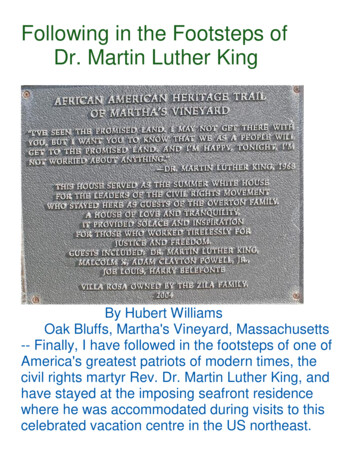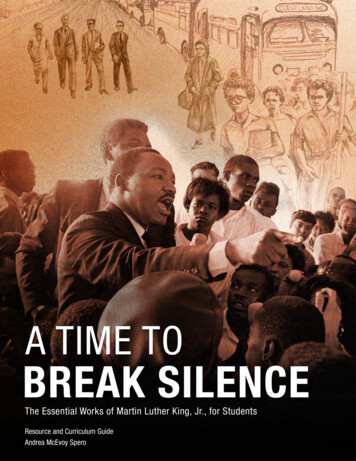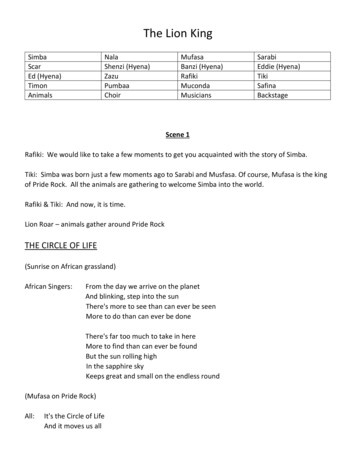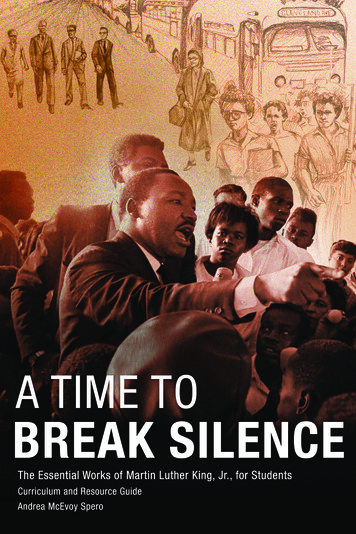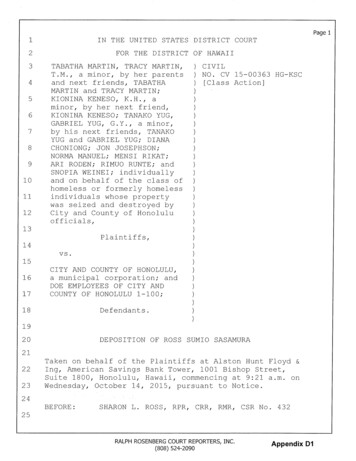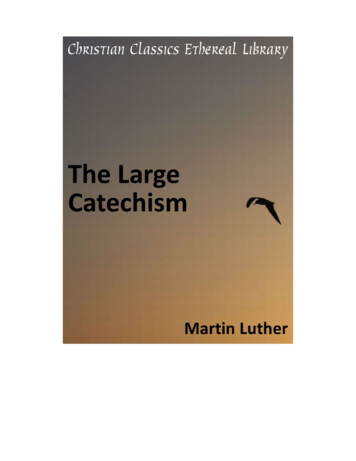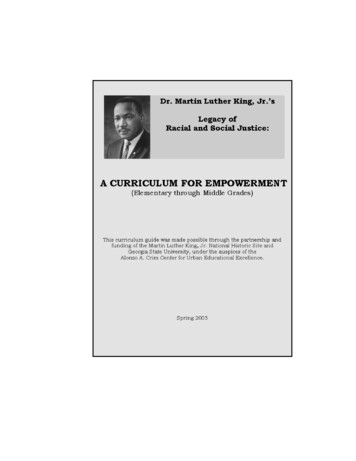
Transcription
DR. MARTIN LUTHER KING, JR.’S LEGACYOF RACIAL AND SOCIAL JUSTICE:A CURRICULUM FOR EMPOWERMENTTABLE OF CONTENTSLetter of Endorsement . iiiAcknowledgements . ivForeword . vIntroduction . 9Curricular Goals and Objectives: . 11The Guiding PrinciplesSection A:Guidelines for Teachers . 13About this Guide . 14How Children Develop Racial and Cultural. 18Identity and AttitudesCautions and Clarifications. 22A Sample Parent Letter . 26Educational Opportunities . 27Overview of Lessons. 28Section B:Lesson Plans/Units . 32K through 3 Lesson Plans/Units:Dr. King’s Life and the Words .33Associated with HimNames, Names, Names .46vi
Dr. King’s Leadership and Character .59Grades 4 and 5 Lesson Plans/Units .72Picturing Nonviolence and Nonexistence .73People of Peace . 86If It Is to Be, It Is Up to Me . 103Grades 6 through 8 Lesson Plans/Units . 126The March On Washington .127Peace Studies: Where in the World Is Peace? . 144Portraying the Dream. 137The Civil Rights Movement:. 144The Next GenerationDr. Martin Luther King, Jr. and Me (Unit) . 206Section C:The Visitor Center Exhibits . 235Segregation. 236The King Family. 240Call to Lead . 244Timeline . 247Visiting the Mountain . 248Expanding the Dream . 251Overcoming Loss . 256Freedom Road . 259Answers to Questions from the . 261Visitor Center Exhibitsvii
Section D:A Problem-Solution Project . 270Overview and Rationale. 271Cross-Curricular Lesson Ideas . 273Learning Objectives . 276Critical Questions . 279Materials and Resources . 280A Teacher’s Procedures and Reflections. 283References . 298Resources for the Classroom. 299Bibliography . 304Appendices . 306A:Timeline of Martin Luther King Jr.’s Life . 307B:Piloting Questionnaire . 332viii
Teachers,The Martin Luther King, Jr. National Historic Site andPreservation District was established October 10, 1980 to“protect and interpret for the benefit, inspiration, andeducation of present and future generations the places whereMartin Luther King, Jr. was born, where he lived, worked andworshipped, and where he is buried.”The staff at the Martin Luther King, Jr. National Historic Siteis very fortunate to work with Georgia State University and theAlonzo A. Crim Center for Urban Educational Excellence onthe development of “Dr. Martin Luther King, Jr.’s Legacy ofRacial and Social Justice: A Curriculum forEmpowerment.” We all are committed to providing qualityeducational materials to continue Dr. King’s legacy andphilosophy of nonviolent social change to educators andstudents.We hope that the materials in the curriculum kit bring the richhistory of the Martin Luther King, Jr. National Historic Siteinto your classroom and encourage many more adventures inlearning about Dr. King and the movement he helped create.Sincerely,Frank CatroppaSuperintendentiii
ACKNOWLEDGEMENTSThis curriculum would not have been possible without theeducators who contributed their time, talent, knowledge andexpertise to this project, under the auspices ofGeorgia State University and the Alonzo A. Crim Center forUrban Educational Excellence. The staff of the Martin LutherKing, Jr. National Historic Site wishes to express our sincereappreciation to everyone for your outstanding work. We hopethese partnerships will continue to grow as we all continue toeducate our young people on the life and legacy of Dr. MartinLuther King, Jr.iv
FOREWORDIt is befitting that the actual words of Dr. Martin Luther King,Jr. relate the foreword to Dr. Martin Luther King, Jr.’sLegacy of Racial and Social Justice: A Curriculum forEmpowerment:Man is man because he is free to operate within the framework ofhis destiny. He is free to deliberate, to make decisions, and tochoose between alternatives. He is distinguished from animals byhis freedom to do evil or to do good and to walk the high road ofbeauty or tread the low road of ugly degeneracy.Martin Luther King, Jr., The Measures of Man, 1959.Many of the ugly pages of American history have been obscuredand forgotten.America owes a debt of justice which it has onlybegun to pay. If it loses the will to finish or slackens in itsdetermination, history will recall its crimes and the country thatwould be great will lack the most indispensable element ofgreatness--justice.Martin Luther King, Jr., Where Do We Go from Here: Chaos orCommunity? 1967.Nonviolence is the answer to the crucial political and moralquestions of our time: the need for man to overcome oppression andviolence without resorting to oppression and violence. Man mustevolve for all human conflict a method, which rejects revenge,aggression and retaliation. The foundation of such a method is love.Martin Luther King, Jr., Nobel Prize acceptance speech,Stockholm, Sweden, December 11, 1964.Power at its best is love implementing the demands of justice.Justice at its best is love correcting everything that stands againstlove.Martin Luther King, Jr., Where Do We Go from Here: Chaos orCommunity? 1967.The curriculum that you and your students are about toexperience attempts to emulate the spirit of the words Dr. Kinguttered. The actualization of them is left up to you, theteacher, and the children you inspire.v
INTRODUCTIONOther than parents and caregivers, what individuals are oftenthe most influential in setting and recharging the moral andjudgmental schemata of young minds in our society?Teachers are! What an awesome responsibility, when youreally think about it. Teachers help set the preliminaryagenda for their students’ understanding of right and wrongbehavior, for what emotions should and should not be actedupon, for which behaviors will cause them great pain andnegative consequences, and for what ideas are worthy to bepursued to make a positive contribution to their lives and tothe lives of others.Dr. Martin Luther King, Jr. is one of the most notable rolemodels of character, personal sacrifice, and intelligence thatanyone can point to in recent history. As teachers, we shoulduse his example to help us do our job to the fullest extentpossible. Our children must learn of Dr. King’s life and aboutthe history and challenges that surrounded him, for,unfortunately, many of the same challenges still exist today.There is still bigotry, political and social injustice, anddistortions of historical fact that plague the citizens of Americaand citizenry around the world. Even now, years after LyndonB. Johnson signed the Voting Rights Act of 1964, which gaveAfrican Americans the right to vote in America, in the year2007, Congress will once again cast votes to decide whetherAfrican Americans retain the right to vote. Can you imaginethat this Act has not become a law? Of course, no one wouldbelieve that African Americans will lose their right to vote, butwhat if ?This world is too unpredictable to guess about the outcome ofanyone’s or any group’s future. In a democracy, it is the dutyof each citizen to become an active part in his/hergovernment. But the government is only part of the answer,for the average citizen must take action to do what he/she canto alleviate injustice wherever he/she may find it. Dr. King9
said, “Injustice anywhere is a threat to justiceeverywhere.” In the world, right now, there is child slavery,extreme poverty, suffering, homelessness, physical and mentalabuse, health issues, pollution and erosion of theenvironment, ethnic cleansing, terrorism, and war. Ourchildren will inherit a world that many feel is out of control.As technology brings the world closer and closer, we have anobligation to help our children handle such a world. We canbegin by planting the seeds of moral and civic integrity inkindergarten.The content of this curriculum guide is a start towards makingour children more sensitive to their world. They can becomeinformed activists to change their immediate surroundings –their schools, neighborhoods, and communities. Who knowshow far positive social activism can go? Dr. King certainly hadno idea when he was playing on the sidewalks of AuburnAvenue that he would someday win the esteemed Nobel PeacePrize. Teachers never know what child in their classroom maybecome the next Dr. Martin Luther King, Jr. or the nextMother Teresa.Let us give our children opportunities to develop their fullestintellectual, moral, and civic potential. Let’s empower themtowards peace in our world.Let’s empower them with Dr. Martin Luther King, Jr.’sLegacy of Racial and Social Justice:A Curriculum for Empowerment.We can do no less!10
Curricular Goals and Objectives:The Guiding PrinciplesGoal 1:Students will discover issues of race and social justiceboth past and present.Objective 1.1Students will identify the causes, consequences and effectsof the Civil Rights Movement.Objective 1.2Students will determine the impact of the Civil RightsMovement on the lives of African American’s in the pastand today.Objective 1.3Students will discover the strategies and philosophies thataffected positive change during the Civil Rights Movementof the 1950’s and ‘60’s.Objective 1.4Students will research and investigate racial and socialjustice issues of the 20th and 21st century.Objective 1.5Students will propose solutions to problems of racial andsocial justice in present day America.Goal 2:Students will determine how The Martin Luther King, Jr.National Historic Site and what it stands for can empowerchildren and further the causes of racial and socialjustice in America and throughout the world.Objective 2.1Students will identify and research the major events in thelife of Dr. Martin Luther King, Jr. from his birth to hisdeath.11
Objective 2.2Students will identify the role that Atlanta and some of itscitizens contributed to the Civil Rights Movement and toleadership in America.Objective 2.3Students will analyze Dr. King’s character, leadership,speeches/writings, and beliefs and their effects on history,the Civil Rights Movement, and the world.Objective 2.4Students will synthesize and apply what they learn fromthe Historic Site towards their lives, their community, andevents in present day America.12
13
ABOUT THIS GUIDEIts PurposeDr. Martin Luther King, Jr.’s Legacy of Racial and SocialJustice: A Curriculum for Empowerment is a teacher’sresource guide that provides activities for students inkindergarten through eighth grade to explore the rich history ofthe civil rights movement and the persona of Dr. Martin LutherKing, Jr. Through creative, interdisciplinary lesson plans andinteractive resources, the curriculum focuses on building onstudents’ current civil rights knowledge and helping them tocompare present-day realities to past struggles for justice inAmerica and throughout the world. The Martin Luther King, Jr.Historic Site, the Auburn Avenue area, and surroundingneighborhoods provide a picturesque and reminiscent backdropfor the guide’s goals. In fact, the guide’s greater purpose lies inits goals:(1) To have students discover issues of race and socialjustice in the past and present, and(2) To have students determine how The Martin LutherKing, Jr. National Historic Site and what it stands forcan empower them and further the causes of racial andsocial justice in America and throughout the world.The guide includes reproducible, “teacher friendly” materials insocial studies, civics, history, writing, reading/language arts, andliterature. Through the scaffolding of relevant historical andsociological information within appropriate grade level contexts,students focus on creative problem-solving and experientiallearning. They are encouraged through this curriculum todetermine their own personal agendas for improving racerelations and for becoming advocates for social justice in theircommunities, their country and their world.14
Graphic organizers are a part of each lesson and assist studentsin developing a depth of understanding and awareness of socialissues. Dr. Martin Luther King, Jr. is presented as a role modelof character and leadership in the struggle for racial and socialjustice. As well, the unsung heroes of the struggle arespotlighted to attest to the bravery of the common man. Childrenof courage are profiled who brought humility and compassion tothe civil rights movement, demonstrating, without question, thebest of our humanity. This curriculum goes beyond the range ofteacher/student interactions and learning. It goes to the heart ofthe human spirit to reveal to our children the heritage and legacyof greatness to which each of us is called.Its FormatThe Guide is divided into 5 major sections: Section 1 – Guidelines for Teachers Section 2 – Lesson Plans and Units by grade levels K(kindergarten) and 1, grades 2 and 3, grades4 and 5, and grades 6 through 8 Section 3 – The Visitor Center Exhibits Section 4 – A Problem-Solution Project Section 5 – ReferencesGuidelines for TeachersIt is important for teachers using a new resource for the first timeto get some tips on the best use of the materials and to beforewarned about any possible procedural and/or judgmentalpitfalls. Since this guide deals with issues on race and socialjustice, this section points out the potential sensitive nature ofsuch issues for children and their parents. Teachers should findthe contents both informative and helpful in dealing with his/hervarious constituencies.15
Overview of LessonsA list of the lessons and units by grade level provides the titlesand the topic of each lesson. Teachers may use this section toassist them as they plan the content of lessons and units theywish to teach.Lesson Plans and UnitsThe lesson plans in this guide are interdisciplinary and addressthe Quality Core Curriculum (QCC) objectives outlined for thestate of Georgia. Each lesson plan includes critical questionsfor students and teachers to examine as the lesson is taught.Background building is an important introductory componentfor each lesson. A motivating experience is written to excitestudents about the lesson and to provide a hook for the contentto be learned. There are step-by-step procedures for deliveringthe lesson content and center and extension ideas forreinforcement in small groups. Synthesis ideas are a part ofeach lesson to help students internalize and build on theconcepts learned. Students get opportunities to transfer theirlearning in new and different ways before their visit to theMartin Luther King Jr. Historic Site, during their visit and aftertheir visit. A listing of materials, resources, and references,including online resources accompany each lesson. Graphicorganizers are used to help students more thoroughlyinvestigate and retain ideas. Attachments are meant forteacher use and handouts are to be used by students. Lessonsthat are closely related often constitute a unit wherein severallessons are written to support each other. This structure allowsstudents to better bridge their understanding of more complexconcepts. All of these components complete a package ofexperiential learning.The Visitor Center ExhibitsAt the Martin Luther King, Jr. National Historic Site, Courage toLead is a wonderful exhibit for the students to explore. It16
presents the topics/titles: Segregation, the King Family, Call toLead, Timeline, Visiting the Mountain, Expanding the Dream,Overcoming Loss, Freedom Road, and the Photo Gallery. Foreach topic/title, a list of questions is presented in a visual orgraphic organizer format. The answers to the questions appearat the end of this section. Students will have fun using materialsthat are found in this section of the guide.A Problem-Solution ProjectInspiring students to become critical thinkers and advocates forracial and social justice is the most intriguing challenge of thisguide. A model of a Problem-Solution Project appears in theguide as an example of the type of activities that can be donewith students to stimulate them to become young activists.From simple letter writing tasks to nonviolent demonstrations,caring adults (e.g., parents and teachers) can guide studentstowards making a difference in their neighborhoods,communities, city, state, country and the world. The challengesof solving simple to complex issues in our society are before us.Our children are our most valuable resource.ReferencesThe materials listed in the final section of the guide will assistteachers in finding additional resources to support thecurriculum and their own personal investigations and learning.17
HOW CHILDREN DEVELOP “RACIAL”AND CULTURAL IDENTITY AND ATTITUDESResearchers have discovered important information about howyoung children develop “racial” and cultural identity and attitudes.Some of the key points are listed below. This information can beused as a framework for observing children and for selecting andcreating appropriate lessons and activities.Two-Year-Olds become increasingly aware of the physical aspectsof identify. The awareness of gender is usually noticed first,followed by a curiosity about skin color, hair color and texture, eyeshape and color as well as other physical characteristics.Awareness of disabilities tends to come later than the awareness ofgender and “race;” however, some two-year-olds may begin noticingmore obvious physical disabilities, such as a person using awheelchair.Children between the ages of two and three may begin to be awareof the cultural aspects of gender, noticing that girls play morefrequently with dolls while boys play more often with trucks.Children at this age may also be aware of ethnic identity, noticingsuch things as children eating different cultural foods, celebratingdifferent holidays or not celebrating or recognizing holidays orbirthdays that they view as important.Children may show signs of pre-prejudice (the ideas and feelings invery young children that may later develop into “real” prejudiceswhen reinforced by biases that exist in society). Pre-prejudice isoften manifested by discomfort, fear or rejection of differences.Children at this age may take their first steps toward theappreciation of people who are physically and culturally differentfrom themselves if positive interactive experiences are part of theregular home, school and after-school program environments andactivities.18
Three- and Four-Year-Olds begin to expand their observations ofdifferences and seek greater explanation of those differences. Theyare aware of their own and others’ physical characteristics.Constructing their identity is a primary task. They want to knowhow they got their skin, hair and eye color and may question why“racial” group “color” names are different from the actual colors.Preschoolers are curious about variations within their extendedfamily and the reason why two people with different skin colors maybe considered part of the same group. They begin to wonder if skin,hair and eye color will remain constant, as they begin to recognizethat getting older brings physical changes. Children at this age mayask questions like, “Will my skin color change when I grow up?” or“Will you always be white?”Five-Year-Olds begin to build a group ethnic identity, as well as anindividual identity. They can more fully explore the range ofdifferences within and between “racial” and ethnic groups as well asthe range of similarities between groups.Children at this age begin to understand scientific explanations fordifferences in skin color, hair texture and eye shape. They are alsobeginning to understand the concept of family traditions and familyhistory.Six to Eight-Year-Olds continue to recognize other group membersand begin to realize that their ethnicity is not changeable. They arebeginning to become aware of history, local actions and attitudesfor and against cultural groups. Such new knowledge, influencedin part by the media, may foster personal prejudices that maybecome an integral part of a child’s attitudes and behaviors.Children this age are highly influenced by the way they see peopleinteract and resolve conflicts. Many children in this age grouplearn about culture and “race” with greater cognitive depth andemotional connection than they did at earlier stages. They maybegin to take pride in their own cultural identities and understandthe experiences of others.19
Nine- to Twelve-Year-Olds are gaining a greater understanding ofthe geographic and historical aspects of culture. Although many9-12-year-olds may still be concrete thinkers primarily focused ontheir own experiences, many may be moving into more abstractthinking. They may become aware of the attitudes and behaviors ofpersons in positions of authority within institutional settings, suchas schools, places of worship and youth agencies. They may alsobegin to gain an awareness and understanding of the variousperspectives that have surrounded historical events.Children at this age may understand personal and family strugglesagainst bias and are often willing to discuss culture, “race” anddifferences. A more complex understanding of personal, family andcommunity identity based on cultural values may emerge. Childrenat this age are becoming increasingly aware of the valuing and devaluing of culture and “race” by their peers, the media and thelarger community. The advantages and disadvantages of somegroups politically, educationally and economically are becomingevident and children may informally begin to discuss what they seeas unfairness.Most 9-12 year-olds can understand “racial” and culturalstereotypes; can speak from dominant and non-dominantperspectives; can practice stating the strengths and positive aspectsof various cultures; and can discuss how internalizing a negativeview about self may affect someone’s confidence.References:Bernal, M., and Knight, G. (eds.). (1993). Ethnic Identify:Formation and Transmission among Hispanics and OtherMinorities. New York, NY: SUNY Series/State University ofNew York Press.Derman-Sparks, L. (1989). Anti-Bias Curriculum: Tools forEmpowering Young Children. Washington, DC: NationalAssociation for the Education of Young Children.20
Holmes, R. M. (1995). How Young Children Perceive Race.Newbury Park, CA: Sage Publications.McCarthy, C., and Crichlow, W. (eds.). (1993). Race Identityand Representation in Education. New York, NY: RoutledgePublishing.Phinney, J., and Rotheram, M. (eds.). (1987). Children’sEthnic Socialization: Pluralism and Development.Newbury Park, CA: Sage Publications.Schultz, F. (ed.). (1995). Multicultural Education. (6th ed.)Guilford, CT: The Dushkin Publishing Group/Brown andBenchmark Publishers.Van Dijk, T. (1987). Communicating Racism. Newbury Park,CA: Sage Publications.Reprinted by permission from the Anti-Defamation League as presentedin A World of Difference Institute’s Anti-Bias Study Guide(Elementary/Intermediate Level.)21
CAUTIONS AND CLARIFICATIONSCautions and clarifications appear below to support the teacher whowants his/her students to take action to affect change in thecircumstances that they determine racially and/or socially unjust in oursociety and in societies around the world.CAUTIONS:¾ Teachers should consider the developmental levelsof the students in the classroom. Their emotionaldevelopment is most important to consider whenaddressing issues of race, gender, social status,societal problems and historical inaccuracies.Always attempt to answer students’ questions, butalways, as well, try to give more than one side of theissue. Allow students to draw their own conclusionsbased on accurate information and an abundance ofresources to consult.¾ Stay away from issues and concerns about whichyou have little information. Make certain thatbefore you begin any lesson that you anticipatepossible misconceptions, family and cultural biases,and the trepidations of your school administration.Helping students become social activists is a scaryundertaking for many adults. These situations canoften be less volatile, if parents are consulted througha parent meeting and/or letter and with discussionwith grade level leaders and the school principal.¾ Develop a written plan, which may incorporateportions of this curriculum, or may go beyondwhat is included. Share your plan with otherteachers and the administration. Permission lettersare a must. Keep everybody informed at all times.22
¾ If field trips are a part of your plan, make certainthat you plan for all costs, attire, time schedules,transportation, chaperones, and meals. Alwaysinclude lessons that prepare students for why they aregoing on the field trip; what you expect to be done andlearned while on the field trip; and then debrief whatwas actually done and learned once the field trip hasbeen completed.¾ Preview all videotapes and audiotapes that will beshared with students before using them. Yourpreview will allow you to determine the appropriatenessof the content for your grade level and for yourparticular students. Do not use materials that would beoffensive to your students or their families. The previewwill also allow you to develop listening and viewingquestions and research additional information. Thistype of preparation will serve both you and yourstudents well in understanding and using the content ofthe resources.¾ Spend as much time as needed to help studentsunderstand the power of nonviolence and otherpositive change strategies. It is imperative that theyalways be respectful and stretch to see the point ofview of others as they explore controversial issues.Further, help students see that empowerment nevercalls forth “haughty power plays or rebellious rebelrousing.” It is equally important to help studentsunderstand the negative views they may encounterfrom others and both positive and negativeconsequences of their behavior or actions. Knowledgeof conflict resolution strategies and theirimplementation in the classroom should probablyaccompany your use of some components of thiscurriculum. Be strategic in your planning to makecertain that every student has a “mind-and-heartchanging experience” trying to make the world betterfor themselves and others.23
CLARIFICATIONS:¾ The lessons/units in this curriculum guide willtake from 2 to 6 weeks to implement. It is expectedthat teachers will spend as much time as needed toread the suggested materials, often including onlineresources, and become thoroughly knowledgeableabout the topics they wish to implement withstudents.¾ Because the lessons are written within a range ofgrade levels (i.e., K and 1, 2 and 3, 4 and 5, and 6through 8), teachers must decide which of theunits will work best for the specific grade thatthey teach. Remember that the maturity of yourstudents at any grade level is more significant thantheir chronological age.¾ Before completing each lesson/unit, revisit theCritical Questions. Debrief with students theanswers to the critical questions for each lesson/unit.The responses to these questions can provide aninformal assessment of the content.¾ Use the parent letter that appears is this sectionof the guide as an example of the type of letterthat may be sent to parents. The most effectiveletter will be an original one that has your voice andappeals to the commitment of parents.¾ Section 3 of the guide best prepares students for avisit to the Martin Luther King, Jr. NationalHistoric Site. The materials in this section match theexhibits that students will experience at the HistoricSite. Answers to the questions posed for the exhibitsappear at the end of the section.24
¾ Do not use student artifacts that appear in theguide as models for your students. The artifactsare meant to demonstrate a level of expectation forstudents’ work at a specific grade level. Eachstudent’s work should be original and reflect his/herthinking, planning and execution.¾ Once you use the guide, please complete thePiloting Questionnaire (Appendix B). The NationalPark Service and the curriculum developers would likeyour input to continue to revise and improve thepublication to better suit your needs.25
EDUCATIONAL OPPORTUNITIESAT THE MARTIN LUTHER KING, JR. NATIONAL HISTORIC SITEThe Martin Luther King, Jr. National Historic Site iscommitted to providing educational opportunities for yourstudents that enhance and influence learning, understanding,and sharing. As well, we provide meaningful experiences onthe life and legacy of Dr. Martin Luther King, Jr.If you are unable to bri
The Martin Luther King, Jr. National Historic Site and Preservation District was established October 10, 1980 to “protect and interpret for the benefit, inspiration, and education of present and future generations the places where Martin Luther King, Jr. was born, where
